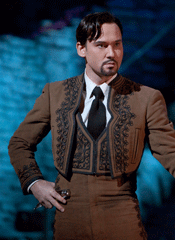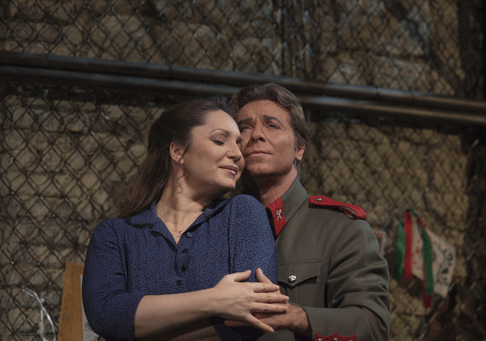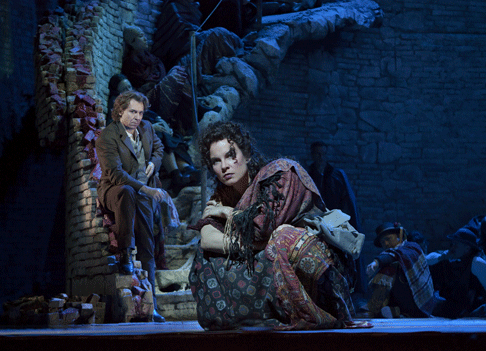Nearly everything else is on display, from the legs she
bathes shamelessly while singing the “HabaÒera” to the shoulders
she bares — in daylight hours? in Spain? — in her
ruffled Act IV gown. As the Latvian mezzo soprano is a beautiful woman, a fine
actress and dancer with a voice of great warmth and sheen — and
fill-the-house power when she chooses to unleash it — no one could object
to her performance as Bizet’s eternal Gypsy. True, she is on the sexually
aggressive side among Carmens and I find more convincing the casual approach of
Olga Borodina, unimpressed by the ogling men around her. Borodina’s
Carmen seemed her own woman, making her own choices, one of which might
be love. This seems a less clichÈ way of playing the character. Most
Carmens work too hard, as if men’s opinions mattered to them, and
Garanča, though with her looks she hardly has to work —
anyone would stare — edges towards that sort of show-off Carmen.
I presume she does things like snap her cleavage from stage center because she
has been directed to do so and because the performance was the camera-dress,
the last before the live high-definition telecast.
> Mariusz Kwiecien as Escamillo
Mariusz Kwiecien as Escamillo
Nor did Garanča’s self-conscious sex appeal get in the way of
her singing: The “HabaÒera” was a parade, the
“Seguidilla” intimate, the dance for Don JosÈ very hot, the
fortune-telling very earthy — crouched over her cards, lacking any sort
of glamour, she held every eye and ear in the house. She was not only the
centerpiece but the only vocally irreproachable star of the performance.
Roberto Alagna, who used to be a first-rate Don JosÈ, sounded strained, flat on
exposed notes (such as the last of “Dragon d’Alcala”), and
ill-adjusted to register breaks, though of course he had the best French of the
evening. His acting was passionate, and he pulled himself together for a
murderous final confrontation. Barbara Frittoli had trouble placing her notes
in the Act I duet with Alagna, sounding uncertain and lacking force, though she
brought down the house in Act III. Mariusz Kwiecien looked elegant as
Escamillo, but sang with that rough bark he often uses these days, instead of
the wonderful — often wonderfully sinister — leggiero sound he
makes when singing Mozart. Small roles were filled ably and, in the case of
Keith Miller, a commanding Zuniga, rather better than that.
I’ve been bitching for some time about new Met productions that are
not only weird but whimsically so, so that future performers will be
straitjacketed into their weirdness; so when a new production like this comes
along of one of the repertory staples, a production that could easily be
inhabited by the varying interpretations of many singers, I’d be rank
ungrateful to complain that it lacks a point of view. Richard Eyre has chosen
to tell Bizet’s story — not his own irrelevant story — in
handsome stage pictures with no interpolated funny business, and I applaud.
Even posing for a photographer in Act IV comes at a moment when it does not
interrupt the music and the character — Escamillo — might
believably pose for a photographer.
 Barbara Frittoli as Micaela and Roberto Alagna as Don JosÈ
Barbara Frittoli as Micaela and Roberto Alagna as Don JosÈ
What did irritate me a bit — but this is part of the standard approach
to the classics in our era — is that the direction has tightened the
screws of sexual and other kinds of brutality. Soldiers cannot casually flirt
with naÔve Micaela — they threaten to rape her the moment she appears,
and she narrowly escapes. The smugglers do not gallantly tie Zuniga up in their
den — they torture him a bit just for the hell of it, while singing the
gallant phrases of the superb Meilhac and HalÈvy libretto. The period of the
piece has been advanced, it seems, to the era of Spain’s Second Republic,
just before the Civil War, and perhaps we are to understand the tension between
soldiers and civilians, smugglers and the law, as a foretaste of the horrors to
come — I don’t know.
gray and red brick. The period is not a great one for showy costumes, and even
the toreadors don’t shine much — one sees more elegant suits of
lights on Halloween. Carmen’s Act IV number with its trail of ruffles on
the floor seems designed solely so that Garanča can look helpless the
when groveling Alagna pounces upon it — an effective moment that did make
us gasp.
 Elina Garanča as Carmen and Roberto Alagna as Don JosÈ
Elina Garanča as Carmen and Roberto Alagna as Don JosÈ
Two dancers, perhaps representing archetypal Male and Female or Yang and Yin
or the infertile stage director and his Muse or a desperate attempt to give
Christopher Wheeldon something to do, make a nuisance of themselves during the
preludes to Acts I and III.
Yannick NÈzet-SÈguin conducted with terrific verve and snap, and I would
have preferred to concentrate on his music-making when those dancers were
making such a spectacle of themselves. The Act III prelude, in particular, is
such a lovely, graceful mountain pastorale and leads so perfectly into the
scene of shattering bliss that follows that staging it seems wildly
intrusive.
John Yohalem
image=http://www.operatoday.com/Garanca_Carmen_Met.gif
image_description=Elina Garanča; as Carmen [Photo by Ken Howard courtesy of The Metropolitan Opera]
product=yes
product_title=Georges Bizet: Carmen
product_by=Carmen: Elina Garanča; Micaela: Barbara Frittoli; Don JosÈ: Roberto Alagna; Escamillo: Mariusz Kwiecien. Production by Richard Eyre. Metropolitan Chorus and Orchestra, conducted by Yannick NÈzet-SÈguin. Performance of January 12, 2010.
product_id=Above: Elina Garanča; as Carmen
All photos by Ken Howard courtesy of The Metropolitan Opera.